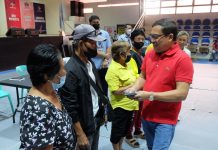DAVAO City -The Department of Social Welfare and Development (DSWD) headed by Secretary Corazon “Dinky” Soliman and the Donor Mission visited Baganga, Davao Oriental and New Bataan, Compostela Valley on January 15 and 16.
Together with Secretary Soliman were New Zealand Ambassador to the Philippines Reuben Levermore; Vicente Selles Zaragozi, General Coordinator of the Spanish Agency for International Development Cooperation (AECID); Octavia Borthwick, Minister Counsellor for the Australian Agency for International Development (AusAID); Luke Myers, Head of Cooperation of the Canadian International Development Agency (CIDA); Reed Aeschliman, Deputy Mission Director of the United States Agency for International Development (USAID); Ugochi Daniels, Country Representative, United Nations Population Fund (UNFPA); William Wairoa-Harrison, Security Advisor, United Nations Department of Safety and Security (UNDSS) and Asaka Nyangara, Deputy Country Director for the Philippines, World Food Programme (WFP).
The group visited the Incident Command Post (ICP) in Baganga for a brief cluster meeting. Provincial Planning and Development Officer Engr. Freddie Bendulo presented the Reconstruction and Development Framework of the province. He said, Davao Oriental aims to continuously provide Emergency Humanitarian Response of Relief Operations until June 2013 and Early Recovery or Rehabilitation and Provision of Livelihood from January to December 2013.
Moreover, they are looking into a new concept named ‘Building Back Better’ or the land use and sectoral re-planning for the reconstruction, livelihood and industry development from January 2013 until December 2016. The estimated cost of the said reconstruction and development framework is around P 2.78 billion, he added.
“The objective of the Mission is for us, the international donors, to see what the challenges are in the area and what the responses should be. We like the province’s concept of ‘building back better’ and integrating it to the medium and long-term plans,” said Ugochi Daniels of the UNFPA.
The Mission also aims to ensure that the support coming from the international humanitarian communities are appropriate and pertinent to the needs of the internally-displaced persons (IDPs).
On the other hand, Lieutenant Colonel Krishnamurti Mortela of ICP Baganga informed that the extent of damage that ‘Pablo’ brought surmounted to around P 13M based on the Provincial Disaster Risk Reduction Management Council (PDRRMC – Davao Oriental). LTC Mortela said that all 18 barangays in Baganga are 95% damaged as to infrastructure and agriculture.
The team also saw the bunkhouses built by DSWD and IOM (International Organization for Migration) in Barangay Mainit, Cateel town.
On Tuesday, the team visited Compostela Valley where Gov. Arturo T. Uy reported the Typhoon Pablo Provincial Response. He shared that the province is currently looking for areas for permanent shelter and to acquire such area as soon as possible. “For those residing in ‘no build’ zone, they have to be relocated to a safe area.”
He revealed that some 15,000 hectares of banana plantation were devastated displacing over 5,000 workers and laborers in the banana industry. Damage to infrastructure has reached P 4 million, he said.
“The road to recovery will take a long time that’s why we are coming up with a blue print for recovery,” he added.
Daniels retorted, “It is reassuring and I very much appreciate your focus on rehabilitation, resettlement and reconstruction. This is important as we move into this stage of response.”
As of to date, the UN World Food Programme (WFP) has extended 92,598 sacks of rice and 34,000 sacks from the Indonesian Government. USAID has also contributed P504.4 million to purchase rice and roll out cash-for-work activities through WFP while IOM has constructed bunkhouses.
Further, in Baganga town, conducted were 18,231 medical consultations, feeding to 6,584 children as well as psycho-social activities to 739 children.
Meanwhile, DSWD has provided a total of 1,588,662,010.00-worth of assistance which covers food and non-food items including financial assistance and construction of bunk houses.[DSWD]
0 Comments
Oldest






